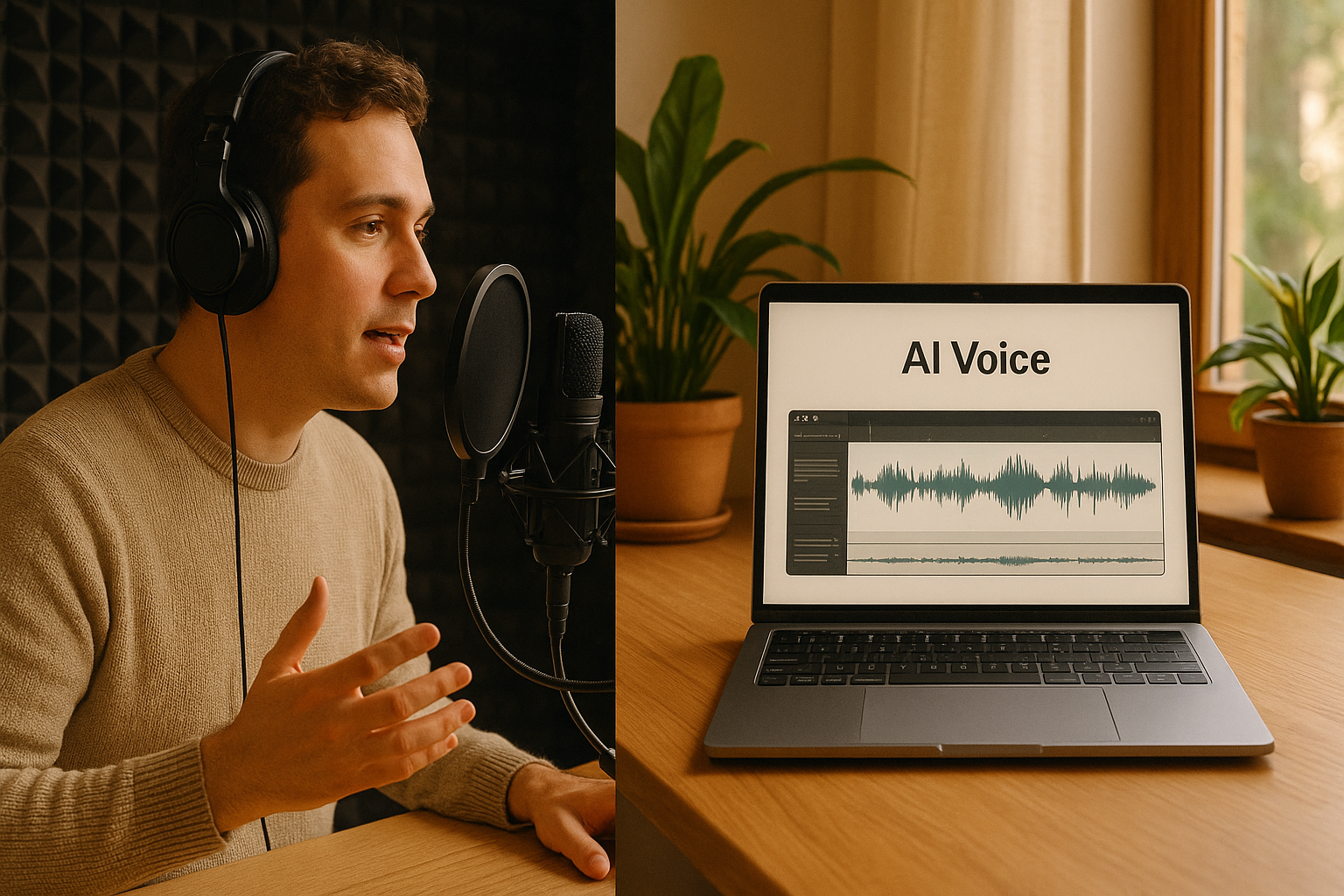You’re staring at your latest project, wondering whether to hire that talented voice actor or try the shiny new AI voice generator everyone’s talking about. It’s not just about saving money anymore; it’s about making the right choice for your audience, your brand, and your future. The human voice over vs AI voice over debate has reached a tipping point in 2025, with both options offering compelling advantages that could make or break your content strategy.
The voice-over industry has transformed dramatically over the past few years. What started as a simple choice between different human narrators has evolved into a complex decision involving cutting-edge technology, audience psychology, and brand authenticity. Whether you’re creating educational content, marketing materials, or entertainment media, understanding the nuances between human and artificial voices will determine how effectively you connect with your audience.
This comprehensive guide cuts through the marketing hype to give you the real facts about human voice-over vs AI voice-over. We’ll explore the actual capabilities and limitations of both approaches, backed by recent research and industry data. By the end, you’ll have a clear framework for making the right voice-over choice for your specific needs.
Understanding the Core Difference Between Human Voice and AI Voice
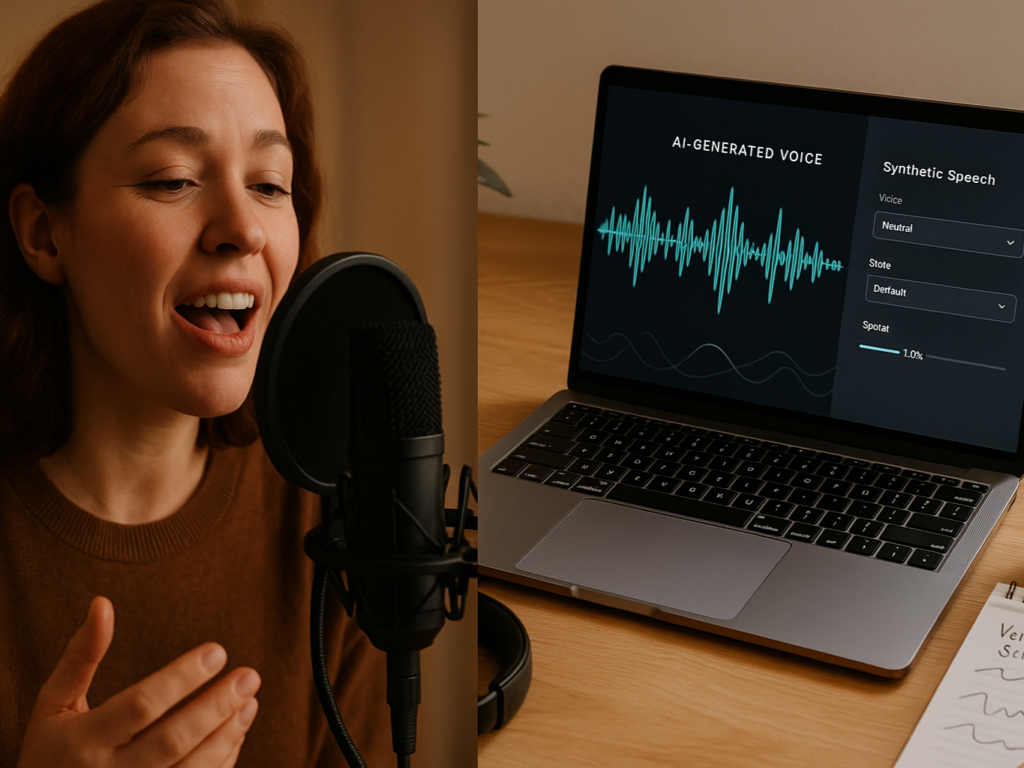
The fundamental difference between human voice and AI voice is how each processes and delivers information. Human voice actors bring decades of life experience, emotional intelligence, and cultural understanding to every word they speak. They can read between the lines of your script, adjusting their delivery based on subtle context clues that might escape even the most sophisticated AI system.
1. Vocal Tone, Emotion, and Personality
Human voice actors intuitively understand emotional nuance from living, breathing, and experiencing the full spectrum of human emotions. When they encounter a script about loss, celebration, or frustration, they draw from their emotional reservoir to create authentic delivery. This emotional authenticity resonates with listeners subconsciously, creating deeper engagement and trust.
According to Podcastle AI’s research on voice technology, attitudes toward AI voice technology remain mixed, with 26% of people describing themselves as “cautious” about AI voices. This hesitation often stems from AI’s current limitations in emotional interpretation. When an AI encounters a sentence that could be delivered with sarcasm, empathy, or excitement, it relies on programmed algorithms rather than genuine emotional understanding.
The personality factor cannot be overstated. Human voice actors develop unique vocal signatures that become associated with brands, characters, or content types. Think about how you can instantly recognize certain audiobook narrators or commercial voice actors; the power of human personality shines through vocal delivery.
2. Scripting, Adaptability & Real-Time Adjustments
Professional voice actors adeptly interpret and adjust scripts in real time. During sessions, they correct phrasing, suggest alternatives, adapt pace, and offer varied emotional takes, ensuring optimal delivery.
- Catch and correct awkward phrasing or pronunciation issues
- Suggest alternative deliveries that better match the intended message
- Adapt their pace and emphasis based on the content’s natural flow
- Provide multiple takes with different emotional approaches
While impressive in their consistency, AI voice systems operate within predetermined parameters. They process scripts linearly, applying programmed rules for emphasis, pausing, and inflection. This systematic approach works well for straightforward content but struggles with complex scripts that require interpretive decisions.
The adaptability gap becomes most apparent when dealing with specialized terminology, brand names, or culturally specific content. A voice actor can quickly learn and consistently pronounce your unique product names. At the same time, AI systems require extensive training data or phonetic programming to achieve similar accuracy.
3. Difference Between Human Voice and AI Voice
The difference between human voice and AI voice extends beyond sound quality to encompass the entire creative process. Human voices carry the weight of personal experience, cultural background, and emotional intelligence. Every inflection reflects years of social interaction and communication skills developed through real-world relationships.
| Aspect | Human Voice | AI Voice |
| Emotional Range | Natural, intuitive, contextual | Programmed, limited, improving |
| Adaptability | Real-time adjustments, creative input | Fixed parameters, consistent output |
| Personality | Unique, memorable, brand-building | Customizable but artificial |
| Cultural Nuance | Inherent understanding | Requires extensive programming |
| Spontaneity | Natural improvisation | Scripted responses only |
Can AI Mimic Human Voice? What You Should Know
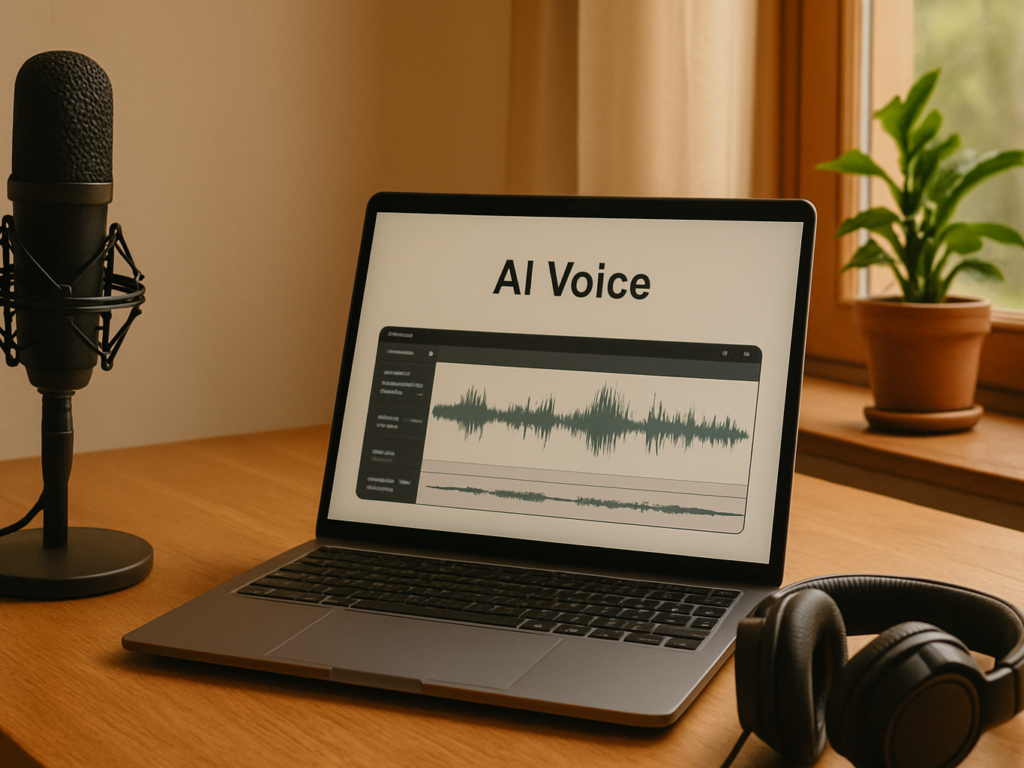
“Can AI mimic human voice?” has evolved from science fiction curiosity to a practical business consideration. Modern AI voice technology has made remarkable strides, with some systems producing audio that is increasingly difficult to distinguish from human speech. However, mimicking and truly replicating are two very different achievements.
1. The Rise of Neural Voice Models
Leading AI voice platforms like ElevenLabs, Descript, and Play.ht have revolutionized what’s possible with synthetic speech. These neural voice models analyze thousands of hours of human speech to learn intonation patterns, breathing, and vocal texture patterns. The results can be startlingly realistic, especially for straightforward, informational content.
- Voice cloning technology can create a digital version of a person’s voice with minimal audio samples.
- This technology offers new opportunities for content creators to maintain brand consistency.
- Ethical concerns regarding consent and authenticity have emerged alongside these advancements.
The global AI voice cloning market is projected to experience explosive growth, with expectations to reach $7.75 billion by 2029 at an annual growth rate of 23.9%. This rapid expansion is a reflection of the technology’s advancing capabilities and wider market adoption.
2. Why AI Still Misses the Human Mark
Despite impressive technical achievements, AI voice technology still struggles with fundamental aspects of human communication. Its most significant limitation lies in emotional intelligence, which is grasping meaning in context, interpreting subtext, and conveying appropriate emotional weight. These are areas where human voice actors naturally excel.
Consider humor and sarcasm, which are both heavily dependent on timing, culture, and shared understanding. Humans intuitively pause before punchlines or deliver sarcasm with precision, while AI lacks this nuance. Cultural context also challenges AI; regional dialects, generational cues, and social subtleties require deep programming, whereas humans instinctively adapt through lived experience.
3. Listener Studies & Perception Gaps
Based on recent findings in cognitive load theory, audiences process human and AI voices differently. In short video advertisements, a human voice-over has been found to significantly lessen the cognitive load on consumers when compared to an AI voice. This reduction in mental effort leads to a higher likelihood of purchase.
- Listeners’ brains use different processing pathways when encountering human voices than AI voices.
- These pathways are associated with social connection and trust.
- This neurological response creates a foundation for deeper engagement and retention.
- AI voices have not yet achieved this level of engagement and retention consistently.
- The psychological impact of human voices extends beyond mere preference.
Brain wave studies comparing listener responses to human and AI voices reveal measurable differences in attention patterns and emotional engagement. Listeners tend to maintain higher attention levels with human voices, particularly during longer content like podcasts or audiobooks. This attention differential translates directly into content effectiveness and audience retention.
Should I Use My Voice or AI? Decision Factors to Consider
The question “Should I use my voice or AI?” doesn’t have a universal answer; it depends on your specific circumstances, goals, and audience. The decision requires weighing multiple factors, including budget constraints, time availability, content type, and long-term branding strategy.
1. Solo Creator Perspective
As a solo content creator, your voice becomes part of your brand identity. Your audience connects with you as an individual, making your authentic voice a valuable asset that builds trust and recognition over time. However, this decision can influence practical considerations like recording quality, time investment, and personal comfort with voice work.
Budget Considerations for Independent Creators:
- Professional recording equipment and acoustic treatment require an upfront investment.
- These investments eliminate ongoing costs associated with voice talent or AI subscriptions.
- Using your voice provides complete creative control.
- Using your voice eliminates scheduling dependencies.
According to Authority Hacker’s AI statistics, 97% of mobile users utilize AI-powered voice assistants, indicating growing comfort with AI voices in specific contexts. This acceptance might make AI voices more viable for particular content types, even personal brands.
The personality connection factor cannot be ignored. When your audience subscribes to your content, they often subscribe to you as a person. Your voice, unique characteristics, and personality traits distinguish your content from countless alternatives.
2. Brand or Business Perspective
Business decisions around voice-over involve different considerations than personal creator choices. Scale requirements, multilingual needs, production timelines, and brand consistency all influence the optimal approach. Large organizations often need to simultaneously produce content across multiple languages, regions, and platforms.
Enterprise-level content production faces unique challenges:
- Maintaining a consistent brand voice across dozens of creators
- Scaling content production to meet demand without compromising quality
- Managing voice talent relationships and scheduling across time zones
- Ensuring legal compliance and rights management across multiple jurisdictions
The cost structure also differs significantly at scale. While individual voice-over sessions might cost $200-500, enterprise agreements with voice talent or AI platforms can dramatically alter the economy. Some organizations find hybrid approaches most effective, using human voices for high-impact content and AI for routine, functional narration.
3. When Mixing Both Might Work Best
The most sophisticated content strategies often combine human and AI voices. This hybrid approach leverages each technology’s strengths while offsetting weaknesses. YouTube creators, for instance, use their real voice for personal branding and intros while relying on AI voices for tutorials, product walkthroughs, or filler content.
Educational creators also benefit from hybrid models. Human voices introduce emotionally engaging lessons, while AI ensures consistent delivery of steps or facts. This balance preserves connection and scales efficiently. The key is matching the voice type to the content purpose; emotional needs suit humans, and repetitive or multilingual tasks suit AI.
Disadvantages of AI Voice That Still Matter in 2025
While AI voice technology has advanced significantly, several disadvantages continue to impact content effectiveness and audience engagement. Understanding these limitations helps you decide when AI voices might not serve your content goals.
- Lacks Genuine Emotional Depth: AI voices often struggle to convey complex emotions like empathy or sarcasm, which reduces their impact on storytelling, customer service, or emotionally sensitive content.
- Limited Contextual Understanding: AI frequently misinterprets sentence flow or emphasis due to its inability to grasp conversational context fully, leading to unnatural or robotic delivery.
- Cultural and Linguistic Inflexibility: AI can mispronounce regional dialects or mishandle culturally specific expressions, negatively affecting listener relatability and global audience reach.
- No Real-Time Adaptability: Unlike human actors, AI cannot adjust tone, pacing, or delivery in real time based on feedback or unexpected changes in the script or mood.
- Ethical and Legal Risks: AI voice-overs can create legal and ethical concerns, including misuse of voice cloning, lack of consent, and unclear copyright ownership of synthetic speech.
AI voices offer efficiency, but their emotional flatness, limited adaptability, and cultural blind spots make them risky for content where trust, nuance, or human connection truly matter.
Production Time, Cost & Scalability Compared
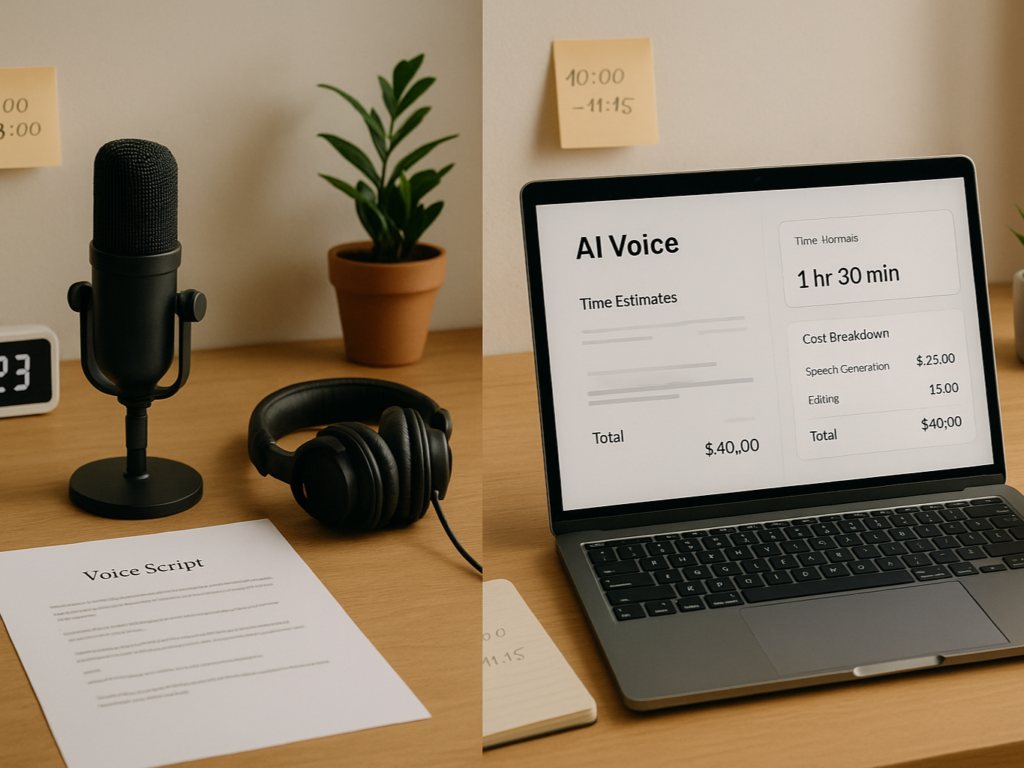
Practical considerations of production time, cost, and scalability often drive voice-over decisions more than creative preferences. Understanding the real-world economics of human voice-over vs AI voice-over helps you make decisions that align with your creative vision and business constraints.
1. Time: Manual Narration vs Instant AI
Human voice-over production involves more than recording. It includes script review, multiple takes, editing, and revision cycles that span days or weeks. Voice actors take time to understand your project, practice specialized terms, and deliver their best performance.
Coordinating adds further time complexity. Scheduling sessions, managing revisions, and liaising with voice talent across time zones often delays timelines. These challenges multiply when multiple actors are involved or when content needs to be delivered in different languages.
AI voice generation delivers near-instant results once the script is ready. Platforms can produce hours of narration within minutes, which is ideal for tight deadlines. Yet AI still requires script optimization, pronunciation tweaks, and quality checks, especially for technical or nuanced content.
2. Cost Breakdown: Dollars vs Pennies
Professional human voice talent typically charges $100-250 per hour for quality work, varying rates based on experience, project scope, and usage rights. High-end voice actors command premium rates, sometimes exceeding $500 per hour for specialized content or extensive usage rights. These costs can quickly escalate for large projects or ongoing content series.
Additional costs for human voice-over include:
- Studio rental fees for professional recording environments
- Audio engineering and post-production services
- Multiple revision rounds and pickup sessions
- Travel expenses for in-person recording sessions
- Rights management and licensing fees for extended usage
AI voice-over platforms typically operate on subscription models that range from $20 to-200 per month, with some platforms charging per-minute or per-character rates. Once you’ve paid the subscription fee, you can generate unlimited content within the platform’s usage limits. This pricing structure makes AI voices particularly attractive for high-volume content production.
The podcast market is expected to surpass $4.2 billion in 2024, indicating a significant economic opportunity for cost-effective voice solutions. The financial advantages of AI voices become more pronounced as content volume increases.
3. Scaling to Multilingual & Multi-Platform Needs
Global content distribution requires voices to communicate effectively across multiple languages and cultural contexts. Human voice actors excel in their native languages and cultural backgrounds. However, scaling to dozens of languages requires extensive talent networks and complex coordination.
- AI voice platforms support 40+ languages and regional dialects.
- This linguistic range allows rapid content localization.
- AI voices ensure brand uniformity in global campaigns.
- Multilingual AI voices may lack cultural nuance and regional authenticity.
The scalability question extends beyond language to platform optimization. Different platforms and content formats may require different vocal approaches; what works for YouTube might not work for podcast distribution or corporate training materials. Human voice actors can adapt their delivery style for other platforms. In contrast, AI voices typically maintain consistent characteristics across all applications.
Audience Trust & Emotional Engagement
The psychological impact of voice choice extends beyond mere preference to influence fundamental aspects of audience trust and emotional connection. Understanding how different voice types affect your audience’s subconscious responses can dramatically improve content effectiveness and brand perception.
1. Brain Response to Voice
Recent neuroscience research reveals fascinating differences in how human brains process human versus AI voices. When listeners encounter human voices, their brains activate neural pathways associated with social bonding, empathy, and trust formation. These evolutionary responses developed over thousands of years of human communication and cannot be easily replicated by artificial systems.
The limbic system, responsible for emotional processing, shows heightened activity when processing human voices compared to AI alternatives. Increased limbic engagement translates to stronger emotional responses, better memory formation, and deeper content engagement. The implications for marketing, education, and entertainment content are profound.
Mirror neuron activation occurs more strongly with human voices, creating subconscious empathy and connection between the speaker and the listener. This neurological response forms the foundation for persuasion, learning retention, and brand loyalty. Despite their sophistication, AI voices do not trigger the same mirror neuron responses.
2. Audience Demographics & Preference Trends
Generational differences in AI voice acceptance matter for audience targeting. Gen Z accepts AI voices in digital contexts but prefers human voices for emotional storytelling and branding. Their AI tolerance is practical, not emotional, highlighting the need for selective, audience-aware voice strategy decisions.
Gen X and Baby Boomers show consistent human voice preference across content types, valuing authenticity and trust. While 73% of consumers favor human voices, this preference shifts with context. AI suits short, functional tasks, but longer content still demands human warmth across all age groups.
3. Difference Between Human Voice and AI Voice in Trust
The difference between human voice and AI voice in trust formation cannot be overstated. Trust develops through consistency, authenticity, and emotional connection, where human voices maintain significant advantages. When Apple faced criticism for AI-generated audiobooks, the backlash highlighted consumer concerns about replacing human narrators with artificial alternatives.
Brand trust implications extend beyond immediate content consumption to long-term relationship building. Organizations that build their brand voice around human authenticity may face challenges transitioning to AI voices without damaging established trust relationships. Conversely, brands that embrace AI voices transparently can build trust around innovation and efficiency.
The transparency factor plays a crucial role in trust formation. Audiences respond more positively to AI voices when identified as artificial rather than attempting to deceive listeners. This transparency allows audiences to adjust their expectations and engage with AI content appropriately.
💡 Speaking of emotional engagement, did you know female voices create a 23% higher sales impact? While you’re weighing human vs AI voices, consider how gender selection affects your brand’s emotional connection. Discover the strategic advantages of female voice-over talent and why leading brands are making this powerful choice.
Read: Female Voice-Over for Brands: 7 Ways It Can Boost Your Message
Where Human Voice Over Still Wins
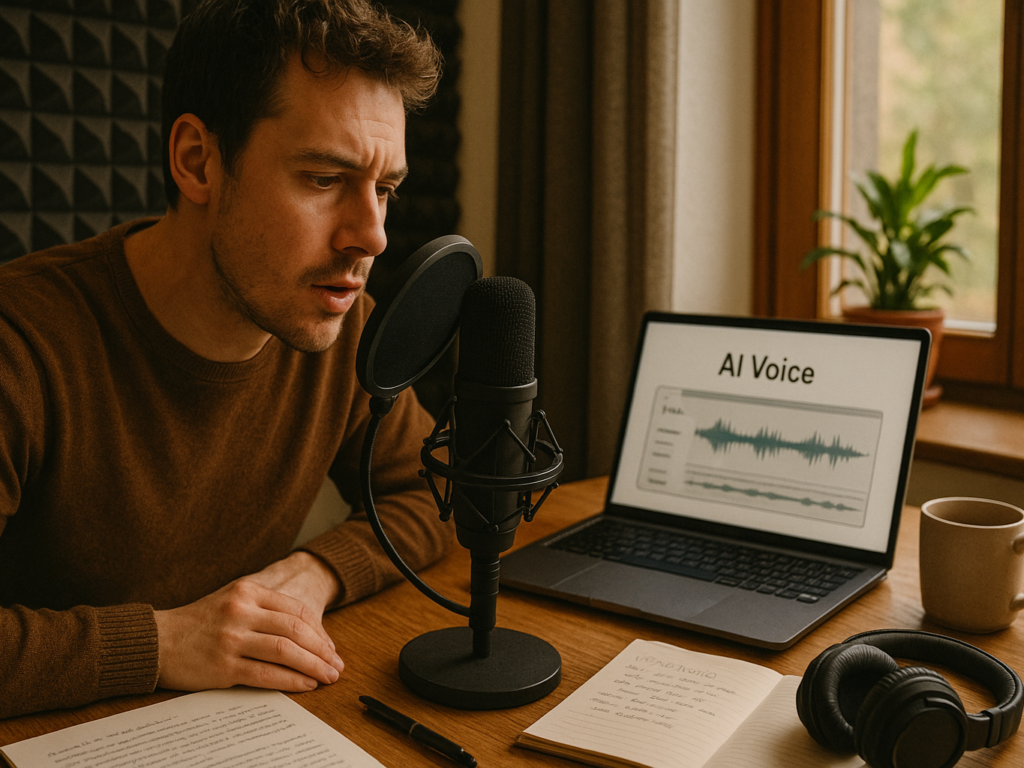
Despite rapid AI advancement, specific content categories and use cases continue to favor human voice-over strongly. Understanding these scenarios helps you effectively allocate your voice-over resources and maintain competitive advantages where human authenticity matters most.
1. Emotional Storytelling and Campaigns
Human voices convey emotion and storytelling depth that AI can’t replicate. Whether it’s a heartfelt charity plea or an exciting product launch, the subtle human tones like tremors or joy forge emotional connections and strengthen message authenticity with a powerful, lasting impact.
Advertising and nonprofit campaigns thrive on human voice-overs. Recognizable voice actors become brand assets, building identity and trust. Especially in sensitive causes, genuine human emotion influences donor generosity and reinforces message credibility far more effectively than artificial alternatives.
2. Audiobooks and Character Acting
The audiobook industry remains a stronghold for human voice talent, particularly in fiction and narrative nonfiction. Character development, dialogue delivery, and emotional pacing require the interpretive skills that human narrators excel at providing. When readers become emotionally invested in characters, they respond to the narrator’s ability to bring those characters to life through vocal performance.
- Complex narratives with multiple characters showcase human voice actors’ abilities to create distinct vocal personas.
- It requires vocal technique, an understanding of character psychology, story arc, and emotional development.
- AI systems cannot yet match this level of interpretive performance.
- Human voice actors maintain narrative coherence in complex narratives.
AI voice companies acknowledge the continued importance of human creativity in audiobook production. Their most successful projects combine AI efficiency with human creative direction and performance guidance.
The intimate nature of audiobook consumption also favors human voices. Listeners often develop personal relationships with their favorite narrators, following them across multiple books and genres. This parasocial relationship building requires the personality and consistency that human performers naturally provide.
3. Customer Support & Complaints
Customer service scenarios, particularly those involving complaints or sensitive issues, require genuine empathy and emotional intelligence that AI voices cannot provide. When customers are frustrated, angry, or upset, they need to feel heard and understood by a real person who can truly comprehend their situation.
Reading vocal cues and adjusting responses accordingly remains a uniquely human skill. Professional customer service representatives can detect frustration, confusion, or satisfaction in a customer’s voice and modify their approach in real time. This adaptive communication skill prevents escalation and builds positive resolution experiences.
Apology delivery presents a particular challenge for AI voices. Genuine apologies require emotional authenticity and personal accountability that artificial systems cannot provide. Customers can instinctively detect when an apology is genuine versus scripted, and this detection significantly impacts their resolution satisfaction and future brand loyalty.
When AI Voice Over Makes Sense

Understanding when AI voices excel helps optimize your content strategy and resource allocation. Specific scenarios strongly favor AI voice-over due to efficiency, consistency, or scale requirements that human voices cannot practically meet.
1. E-learning and Training Content
Educational content focused on information delivery often benefits from AI voice efficiency. Consistent vocal tone across modules helps reduce cognitive load, enhancing learner comprehension, especially in complex technical subjects where clarity and uniformity are critical for understanding.
Large-scale corporate training programs leverage AI voices for consistent delivery across hundreds of hours. When training thousands of employees, AI ensures uniform quality, avoiding the variability of multiple human narrators or fluctuating vocal styles.
AI voices excel in multilingual training scenarios. Organizations can quickly scale content globally without hiring international talent. Consistent AI voice output ensures a seamless brand experience across languages, and it is ideal for tutorials, procedures, and factual instruction, not emotional or nuanced messaging.
2. IVR Systems & Chatbots
AI voices thrive in Interactive Voice Response (IVR) systems and chatbots, where users prioritize speed and clarity over emotional connection. These functional communication tools deliver quick answers, making AI a reliable solution for streamlined interactions.
Verloop reports that 39% of consumers expect AI to improve healthcare within five years, largely through automated systems. Functional interactions in healthcare, like appointment reminders or status updates, align well with AI voice strengths in efficiency and accuracy.
For organizations managing high call volumes, AI offers 24/7 consistency without fatigue. Clear communication design and user awareness of AI interaction set proper expectations, shifting focus from empathy to performance and reliability in customer experience.
3. Global Scale Campaigns
International marketing campaigns requiring rapid deployment across multiple markets and languages often benefit from the advantages of AI voice. The ability to generate consistent brand messaging in dozens of languages simultaneously enables global campaign coordination that would be logistically challenging with human voice talent.
- A/B testing capabilities are a significant advantage for AI voices in global campaigns.
- Marketers can rapidly test different vocal approaches, emphasis patterns, or emotional tones across different markets.
- Testing can be done without the multiple human recording sessions’ time and cost requirements.
- This testing capability enables data-driven optimization.
- Data-driven optimization improves campaign effectiveness.
Brand consistency across diverse global markets becomes easier to maintain with AI voices. While human voice actors bring cultural authenticity, they also introduce variability that can dilute brand messaging. AI voices provide consistent brand voice characteristics while adapting to local language requirements.
However, cultural sensitivity remains a challenge for AI voices in global campaigns. Local cultural nuances, humor styles, and communication preferences may be lost in AI translation, potentially reducing campaign effectiveness in specific markets.
Hybrid Voice Strategy: Best of Both Worlds
The most sophisticated content strategies combine human and AI voices strategically, leveraging the unique strengths of each approach while mitigating their respective limitations. This hybrid approach represents the future of professional voice-over strategy.
1. Case Studies Using Blended Voice Approaches
Leading brands have successfully implemented hybrid voice strategies that optimize efficiency and engagement. Duolingo uses human voices for its leading character personalities and brand messaging while employing AI voices for the thousands of individual lesson components. This approach maintains brand personality while enabling the massive scale their platform requires.
YouTube creators increasingly adopt hybrid approaches, using their authentic human voices for channel introductions, personal commentary, and subscriber interaction while employing AI voices for tutorial sections, product descriptions, or supplementary content. This strategy maintains the personal connection that drives subscriber loyalty while reducing production time for routine content.
The key to successful hybrid implementation lies in strategic voice assignment based on content purpose and audience expectations. High-engagement, relationship-building content benefits from human authenticity, while informational, procedural content can effectively utilize AI efficiency.
2. Workflow Tips: When to Use Which Voice
Developing clear criteria for voice selection streamlines production workflows and ensures consistent quality across your content library. Consider implementing decision frameworks based on content type, audience engagement requirements, and production constraints.
Emotional content filters help determine when human voices provide maximum value:
- Personal stories, testimonials, and case studies benefit from human authenticity
- Brand messaging and company values communication require a human personality
- Customer-facing content that builds relationships needs human connection
- Sensitive topics requiring empathy and understanding demand human emotional intelligence
Functional content often works effectively with AI voices:
- Step-by-step tutorials and procedural information
- Technical specifications and product descriptions
- Frequently updated content requiring consistency
- Multilingual content requiring rapid deployment
Production timeline considerations also influence voice selection. When tight deadlines and content are primarily informational, AI voices provide practical advantages. When time allows for proper human voice production and content requires emotional engagement, human voices deliver superior results.
3. Tools That Support Hybrid Models
Modern platforms like Descript, ElevenLabs, and Speechelo enable seamless integration of human and AI voices. They support efficient workflows, maintain consistent audio quality, and simplify complex processes for hybrid content creation tailored to diverse project needs.
Success with hybrid tools depends on understanding each platform’s capabilities and using them strategically. Creators must balance AI efficiency with human authenticity to deliver engaging, brand-consistent content that meets both technical demands and emotional expectations.
Future of Voice Over: Trends to Watch

The voice-over industry continues to evolve rapidly, with emerging technologies and changing consumer expectations shaping the future landscape. Understanding these trends helps you make strategic decisions that position your content for long-term success.
1. Advances in AI Emotion Simulation
Cutting-edge AI research focuses on improving emotional intelligence and contextual understanding in synthetic voices. Neural networks trained on massive datasets of human emotional expression are beginning to produce more nuanced and contextually appropriate vocal responses. These advances suggest that the emotional gap between human and AI voices may narrow significantly over the coming years.
- Sentiment mapping technology allows AI to analyze text for emotional context and adjust vocal delivery.
- Voice modulation advances enable AI to adjust tone, pace, vocal texture, breathing patterns, and micro-expressions.
- These technical improvements bring AI voices closer to human-like emotional expression.
- AI systems maintain consistency and scalability advantages.
However, genuine emotional intelligence requires more than technical vocal manipulation. Accurate emotional understanding involves cultural context, personal experience, and social awareness that current AI systems cannot replicate. The question remains whether technological advancement can bridge this fundamental gap.
2. Ethical Debates & Regulation Movements
Growing concerns about AI voice misuse have prompted global regulatory discussions. Voice cloning raises issues around consent, fraud, and intellectual property rights that current laws fail to address fully. This legal uncertainty impacts creators, consumers, and voice professionals in evolving markets.
Governments and industry groups are developing disclosure rules and ethical guidelines to manage AI voice usage. Unions advocate for voice actor rights, while consent protocols for cloning are emerging as standard, mirroring model release practices in media production.
3. Will AI Ever Fully Replace Voice Actors?
Industry experts remain divided on whether AI will eventually fully replace human voice actors. While technical capabilities continue improving, fundamental aspects of human communication may always require authentic human expression. The question shifts from “if” to “which applications” will transition to AI voices.
Premium content categories likely maintain human voice preferences, particularly where emotional connection and authenticity drive value. Audiobooks, high-end advertising, and entertainment content may continue favoring human voices even as AI capabilities improve.
Functional and informational content represents the most likely areas for AI voice adoption. As AI emotional intelligence improves, the line between functional and emotional content may shift, potentially expanding AI voice applications into previously human-dominated areas.
🎯 Ready to Take Your Voice Strategy Further?
Now that you understand the human vs. AI voice decision, dive deeper into the psychology of voice selection. Research shows female voice-over artists generate stronger emotional responses and build greater brand trust across demographics. Discover why 73% of audiences prefer the human touch, especially when it’s the right human voice.
Explore: 7 Ways Female Voice-Over Can Transform Your Brand Message
Final Verdict: Human Voice Over vs AI Voice Over
Choosing between Human voice-over vs. AI voice-over depends on your project’s unique goals. Emotional depth, brand trust, and audience connection favor human narration. On the other hand, AI excels in scalability, speed, and cost-efficiency. Matching voice type to content purpose ensures you deliver the right impact.
Consider key factors like budget, emotional tone, timeline, and audience expectations. Human voices build trust and engagement, which is ideal for storytelling and high-stakes campaigns. AI suits technical, repetitive, or large-scale content where speed and multilingual output matter. Strategic use of each maximizes results across different content types and platforms.
Statistics reinforce this approach: 73% of listeners prefer human voices for emotional content, while AI voice adoption grows 23.9% annually. Human narration reduces listener fatigue and enhances brand trust. Success lies in selecting voice solutions that align with your goals, whether deep connection or fast, global scalability.
